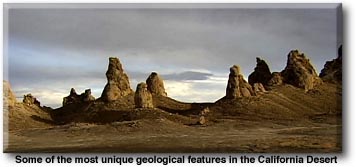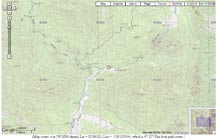Astro 28M : Field Astronomy
in the High Desert - Native American Sites and a Lunar Graze
Mar 19-21, 2010
Registering
for the class
Schedule
PostTrip
Photo Page
In this course, we'll introduce you
to some concentrated astronomy and planetary science in a stark and beautiful
setting, under the clean dark skies of the high desert. The astronomical highlight
is a bright grazing lunar occultation, which passes through the Domelands and
Chimney Peak Wilderness areas north of Lake Isabella. We'll study the star formation
areas of the Orion Spiral Arm of our Milky Way Galaxy on Friday night. Saturday
morning I'll cook my famous French Crepes breakfast for the team, and we'll
explore the local geology. Most of our group will do hikes in  the
local area to learn of planetary science, the geology of the Earth, the Sierra,
and the geologic history of the Mojave and southern Sierra. We also plan to
visit site(s) showing ancient Native American pictographs and petroglyphs, I
will try to get permission to access the Little
Lake archeology sites, which are next to a privately owned by
very beautiful lake on the edge of a lava cliff. (There are also
petroglyphs at Sheep
Spring in Red Rock Canyon State Park). In the afternoon, we may
have time to drive out to the ancient Pleistocene formations known as the Trona
Pinnacles National Natural Landmark (photo at left, and, another
link) - a famous location used in many sci-fi movies because of
its bizarre and other-wordly geology. Saturday evening we'll arrive back at
camp for dinner
the
local area to learn of planetary science, the geology of the Earth, the Sierra,
and the geologic history of the Mojave and southern Sierra. We also plan to
visit site(s) showing ancient Native American pictographs and petroglyphs, I
will try to get permission to access the Little
Lake archeology sites, which are next to a privately owned by
very beautiful lake on the edge of a lava cliff. (There are also
petroglyphs at Sheep
Spring in Red Rock Canyon State Park). In the afternoon, we may
have time to drive out to the ancient Pleistocene formations known as the Trona
Pinnacles National Natural Landmark (photo at left, and, another
link) - a famous location used in many sci-fi movies because of
its bizarre and other-wordly geology. Saturday evening we'll arrive back at
camp for dinner before sunset, and then deploy our stations for the graze which happens just
as twilight is ending. The graze is visible only along a very narrow path which
passes a few miles north of our campground.
before sunset, and then deploy our stations for the graze which happens just
as twilight is ending. The graze is visible only along a very narrow path which
passes a few miles north of our campground.
The areas we'll be exploring show
some of the best examples of plate tectonic-induced faulting, volcanism, and
Ice Age geology anywhere in world. Our campground is Chimney
Creek campground. The most direct route there is to drive up Hwy
178 out of Bakersfield, past Lake Isabella, to the tiny town of Canebrake, then
take Canebrake Road 10 miles further north. It is graded dirt that is easy passable
by 2wd passenger cars, but don't expect to go much more than 35 mph, and usually
slower. The famous Pacific Crest Trail crosses Canebrake Road 0.2 miles south
of Chimney Peak Campground. Here's another
account, which mentions that the road should be passable by most
ordinary cars. It should be pretty vacant this time of year - and cold at night.
Bring your thermals! A link to some useful
info on the roads near the campsite.
 On the return trip on Sunday, we'll
stop at Remington
Hot Springs on the Kern River, here, and soak in wonderfully warm water
while listening to a final lecture.
On the return trip on Sunday, we'll
stop at Remington
Hot Springs on the Kern River, here, and soak in wonderfully warm water
while listening to a final lecture.

The topo map of our campground
- Chimney Creek campground
|

GoogleEarth view of our
campground
|

The sign at the entrance
to the wilderness.
|

The view from
the top of a mountain near camp, showing Kennedy Meadow north of our campground
down below, and white-capped Mt. Whitney far behind |
The Grazing Lunar Occultation
of ZC 570 in Aries
At 8:08pm, right after twilight ends
on Saturday evening, the slender evening cresent moon will just graze
the bright star ZC 570 in Aries. The star will disappear and reappear along
the ghostly earthlit mountains on the northern limb of the moon, and for 3 minutes,
it will vanish and reappear repeatedly as it is covered and uncovered by the
dark lunar hills and valleys seen in profile. Grazes are not only beautiful
to watch, but making precise timings is as simple as shouting "D!"
and "R!" into a tape recorder while radio station WWV broadcasts time
signals. These timings are still the most precise way that astronomers have
for tracking the changing orbit of the moon and calibrating it to the fundamental
FK6 coordinate system tied to the stars. This permits many tests of exotica
such as General Relativity and tidal friction. Read more about grazing occultations
here. I'll bring our 10" LX200 scope and video recording gear.
I'll also have another portable telescope(s) so that we can set up at least
one or two other student stations, if I can get some help in transporting the
telescopes. If you have your own, please consider bringing it!

Graze profile at long=118.
Nice! Promises feast or famine of disappearances and reappearances
|

Graze site, nearest to
Chimney Peak Campground. Elev 6800 ft. An alternative is to go down
to the lower site...
|

Graze site, from Rt 395.
Prime spot is 0.1s, plus 0.10 tanZsinD = 0.20miS of red line (300m nominal
northern limit). On north-bound Hwy 395, the prime spot is Lat=35d 52.07'.
On southbound: 35d 52.13'
|

The crossing on 395 happens
to be 0.27mi south - an excellent if noisey choice in a pinch. Elev
826m
|
Camper's checklist
The Rules of the Game
 the
local area to learn of planetary science, the geology of the Earth, the Sierra,
and the geologic history of the Mojave and southern Sierra. We also plan to
visit site(s) showing ancient Native American pictographs and petroglyphs, I
will try to get permission to access the Little
Lake archeology sites, which are next to a privately owned by
very beautiful lake on the edge of a lava cliff. (There are also
petroglyphs at Sheep
Spring in Red Rock Canyon State Park). In the afternoon, we may
have time to drive out to the ancient Pleistocene formations known as the Trona
Pinnacles National Natural Landmark (photo at left, and, another
link) - a famous location used in many sci-fi movies because of
its bizarre and other-wordly geology. Saturday evening we'll arrive back at
camp for dinner
the
local area to learn of planetary science, the geology of the Earth, the Sierra,
and the geologic history of the Mojave and southern Sierra. We also plan to
visit site(s) showing ancient Native American pictographs and petroglyphs, I
will try to get permission to access the Little
Lake archeology sites, which are next to a privately owned by
very beautiful lake on the edge of a lava cliff. (There are also
petroglyphs at Sheep
Spring in Red Rock Canyon State Park). In the afternoon, we may
have time to drive out to the ancient Pleistocene formations known as the Trona
Pinnacles National Natural Landmark (photo at left, and, another
link) - a famous location used in many sci-fi movies because of
its bizarre and other-wordly geology. Saturday evening we'll arrive back at
camp for dinner before sunset, and then deploy our stations for the graze which happens just
as twilight is ending. The graze is visible only along a very narrow path which
passes a few miles north of our campground.
before sunset, and then deploy our stations for the graze which happens just
as twilight is ending. The graze is visible only along a very narrow path which
passes a few miles north of our campground. 







